boot Citroen C5 2016 (RD/TD) / 2.G User Guide
[x] Cancel search | Manufacturer: CITROEN, Model Year: 2016, Model line: C5, Model: Citroen C5 2016 (RD/TD) / 2.GPages: 366, PDF Size: 30.93 MB
Page 57 of 366
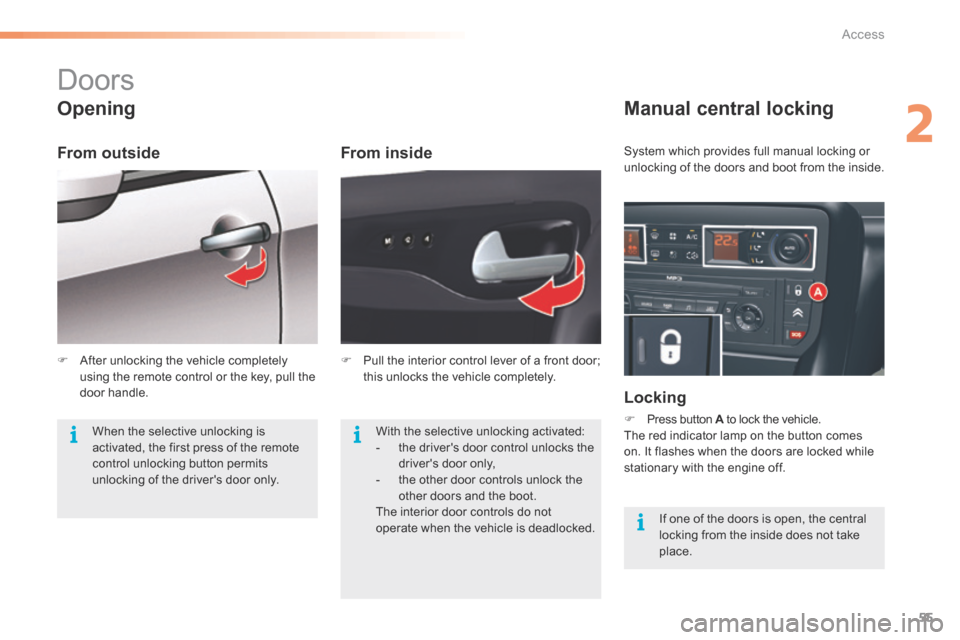
55
C5_en_Chap02_ouverture_ed01-2015
doors
Opening
From inside
Manual central locking
Locking
F Press button A to lock the vehicle.
The red indicator lamp on the button comes
on. It flashes when the doors are locked while
stationary with the engine off.
From outside
When the selective unlocking is
activated, the first press of the remote
control unlocking button permits
unlocking of the driver's door only. With the selective unlocking activated:
-
the driver's door control unlocks the
driver's door only,
- the other door controls unlock the
other doors and the boot.
The interior door controls do not
operate when the vehicle is deadlocked. If one of the doors is open, the central
locking from the inside does not take
place.
System which provides full manual locking or
unlocking of the doors and boot from the inside.
F After unlocking the vehicle completely
using the remote control or the key, pull the
door handle. F
Pull the interior control lever of a front door;
this unlocks the vehicle completely.
2
access
Page 58 of 366
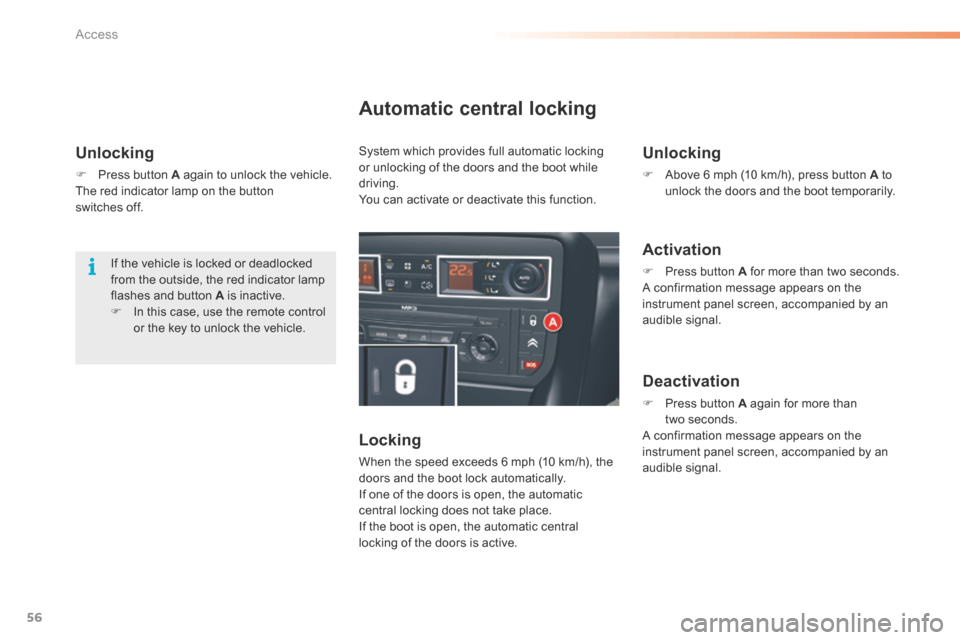
56
C5_en_Chap02_ouverture_ed01-2015
Unlocking
F Press button A again to unlock the vehicle.
The red indicator lamp on the button
switches off.
Automatic central locking
Locking
When the speed exceeds 6 mph (10 km/h), the
doors and the boot lock automatically.
If one of the doors is open, the automatic
central locking does not take place.
If the boot is open, the automatic central
locking of the doors is active.
Unlocking
F Above 6 mph (10 km/h), press button A to
unlock the doors and the boot temporarily.
Activation
F Press button A for more than two seconds.
A confirmation message appears on the
instrument panel screen, accompanied by an
audible signal.
Deactivation
F Press button A again for more than
two seconds.
A confirmation message appears on the
instrument panel screen, accompanied by an
audible signal.
If the vehicle is locked or deadlocked
from the outside, the red indicator lamp
flashes and button A is inactive.
F
In this case, use the remote control
or the key to unlock the vehicle. System which provides full automatic locking
or unlocking of the doors and the boot while
driving.
You can activate or deactivate this function.
access
Page 60 of 366

58
C5_en_Chap02_ouverture_ed01-2015
Boot (Saloon)
F Press upwards on lever 1 and lift up the
boot lid. With the vehicle stationary, this is carried out
using:
-
The remote control.
- The key in a door lock.
- The interior central locking/ unlocking control.
The boot automatically locks when the vehicle
is moving at a speed of over 6 mph (10 km/h),
even if automatic central locking is deactivated.
It is unlocked when a door is opened or when
the central locking button is pressed (speed
lower than 6 mph (10 km/h)).
Opening Locking/unlocking Emergency boot release
Unlocking
F Fold back the rear seats to gain access to
the lock from inside the boot.
F Insert a small screwdriver into hole A of the
lock to unlock the tailgate.
F Push the white part, located inside the
lock, to the left to unlock the boot.
System for mechanical unlocking of the boot
in the event of a battery or central locking
malfunction.
access
Page 61 of 366

59
C5_en_Chap02_ouverture_ed01-2015
Motorised opening
Boot (Tourer)
Manual opening
F Press upwards on lever A and lift up the
tailgate. F
Press upwards on lever A , or press of more
than one second on button B of the remote
control.
Manual closing
F Lower the tailgate using the interior
handle C.
Motorised closing
F Press the push-button D to close the
tailgate.
Do not interrupt the closing of the tailgate;
if any obstacle prevents it closing, the
operation will stop and the tailgate will
automatically rise by a few centimetres.
Do not attempt to help the opening of
the tailgate manually after pressing the
control A
.
2
access
Page 62 of 366
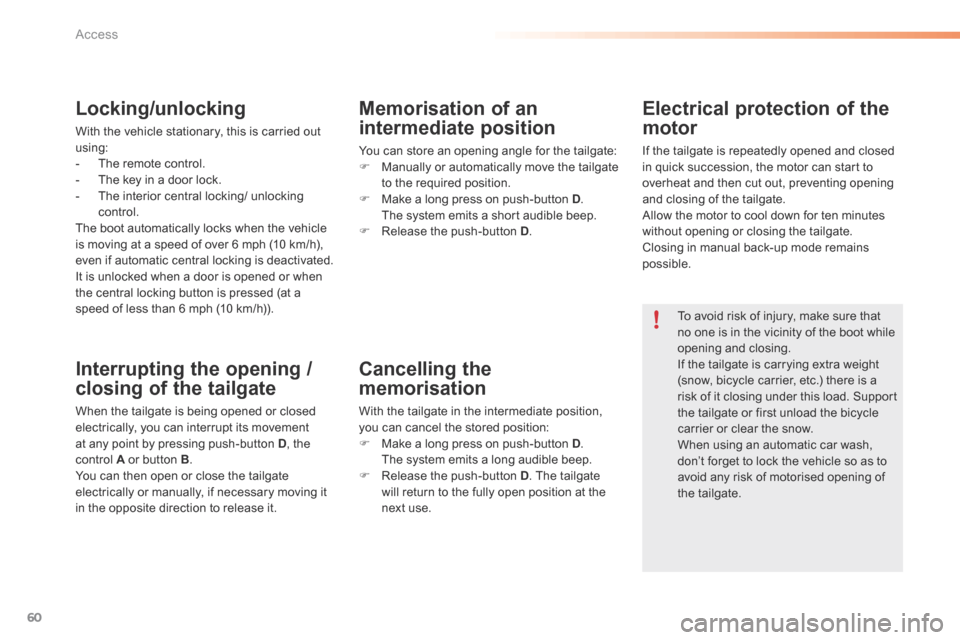
60
C5_en_Chap02_ouverture_ed01-2015
Cancelling the
memorisation
With the tailgate in the intermediate position,
you can cancel the stored position:
F Make a long press on push-button D .
The system emits a long audible beep.
F Release the push-button D . The tailgate
will return to the fully open position at the
next use.
Electrical protection of the
motor
If the tailgate is repeatedly opened and closed
in quick succession, the motor can start to
overheat and then cut out, preventing opening
and closing of the tailgate.
Allow the motor to cool down for ten minutes
without opening or closing the tailgate.
Closing in manual back-up mode remains
possible.
To avoid risk of injury, make sure that
no one is in the vicinity of the boot while
opening and closing.
If the tailgate is carrying extra weight
(snow, bicycle carrier, etc.) there is a
risk of it closing under this load. Support
the tailgate or first unload the bicycle
carrier or clear the snow.
When using an automatic car wash,
don’t forget to lock the vehicle so as to
avoid any risk of motorised opening of
the tailgate.
Memorisation of an
intermediate position
You can store an opening angle for the tailgate:
F Manually or automatically move the tailgate
to the required position.
F Make a long press on push-button D .
The system emits a short audible beep.
F Release the push-button D .
Interrupting the opening /
closing of the tailgate
When the tailgate is being opened or closed
electrically, you can interrupt its movement
at any point by pressing push-button D , the
control A or button B .
You can then open or close the tailgate
electrically or manually, if necessary moving it
in the opposite direction to release it.
Locking/unlocking
With the vehicle stationary, this is carried out
using:
- The remote control.
- The key in a door lock.
- The interior central locking/ unlocking
control.
The boot automatically locks when the vehicle
is moving at a speed of over 6 mph (10 km/h),
even if automatic central locking is deactivated.
It is unlocked when a door is opened or when
the central locking button is pressed (at a
speed of less than 6 mph (10 km/h)).
access
Page 73 of 366

71
C5_en_Chap03_ergo-et-confort_ed01-2015
Rear head restraints
The rear head restraints can be removed and
have two positions:
- high, position for use,
- low, storage position.
To raise a head restraint, pull it upwards.
To lower it, press the lug then the head
restraint.
To remove it, place it in the high position, push
the lug and pull it upwards.
To refit it, engage the head restraint rods in the
holes taking care to remain in line with the seat
back.
Rear seats
Bench seat, the left-hand (2/3) or right-hand (1/3) section of which can be folded to adapt the boot load space.
In order to fold a rear seat without any risk of
damage, always start with the seat cushion,
never with the seat backrest:
F Move the corresponding front seat for ward
if necessary.
F Raise the front of the seat cushion 1 .
F Tilt the seat cushion 1 fully against the front
seat.
F Check that the seat belt is positioned
correctly on the side of the seat backrest.
F Lower or remove the head restraints if
necessary.
Folding the seat
F Pull the control 2 for ward to release the
seat backrest 3 .
F Fold the seat backrest 3 fully down.
n ever drive with the head restraints
removed, they must be in place and
correctly adjusted. The seat cushion 1 can be removed to
increase the load volume.
3
Ease of use and comfort
Page 76 of 366
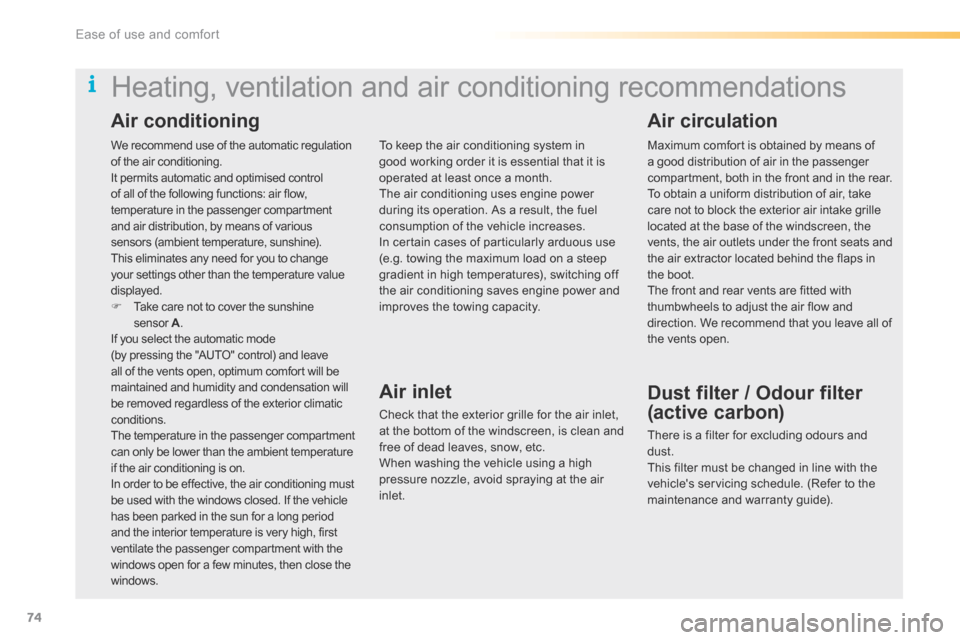
74
C5_en_Chap03_ergo-et-confort_ed01-2015
We recommend use of the automatic regulation
of the air conditioning.
It permits automatic and optimised control
of all of the following functions: air flow,
temperature in the passenger compartment
and air distribution, by means of various
sensors (ambient temperature, sunshine).
This eliminates any need for you to change
your settings other than the temperature value
displayed.
F Take care not to cover the sunshine
sensor A.
If you select the automatic mode
(by pressing the "AUTO" control) and leave
all of the vents open, optimum comfort will be
maintained and humidity and condensation will
be removed regardless of the exterior climatic
conditions.
The temperature in the passenger compartment
can only be lower than the ambient temperature
if the air conditioning is on.
In order to be effective, the air conditioning must
be used with the windows closed. If the vehicle
has been parked in the sun for a long period
and the interior temperature is very high, first
ventilate the passenger compartment with the
windows open for a few minutes, then close the
windows.
Heating, ventilation and air conditioning recommendations
To keep the air conditioning system in
good working order it is essential that it is
operated at least once a month.
The air conditioning uses engine power
during its operation. As a result, the fuel
consumption of the vehicle increases.
In certain cases of particularly arduous use
(e.g. towing the maximum load on a steep
gradient in high temperatures), switching off
the air conditioning saves engine power and
improves the towing capacity.
Air inlet
Check that the exterior grille for the air inlet,
at the bottom of the windscreen, is clean and
free of dead leaves, snow, etc.
When washing the vehicle using a high
pressure nozzle, avoid spraying at the air
inlet. Maximum comfort is obtained by means of
a good distribution of air in the passenger
compartment, both in the front and in the rear.
To obtain a uniform distribution of air, take
care not to block the exterior air intake grille
located at the base of the windscreen, the
vents, the air outlets under the front seats and
the air extractor located behind the flaps in
the boot.
The front and rear vents are fitted with
thumbwheels to adjust the air flow and
direction. We recommend that you leave all of
the vents open.
Dust filter / Odour filter
(active carbon)
There is a filter for excluding odours and
dust.
This filter must be changed in line with the
vehicle's servicing schedule. (Refer to the
maintenance and warranty guide).
Air conditioning
Air circulation
Ease of use and comfort
Page 92 of 366

90
C5_en_Chap03_ergo-et-confort_ed01-2015
Side blinds
F Pull the tab A to unreel the blind.
F Position the blind on the hook B .
Rear blind (Saloon)
F Pull the tab C to unreel the blind.
F Position the blind on the hooks D .
Ski flap
A flap in the backrest, located to the rear of the
armrest, facilitates the carrying of long objects.
To o p e n
F Lower the rear armrest.
F Pull the flap handle down.
F Lower the flap.
F Load the objects from inside the boot.
Ensure that the objects are well secured
and that they do not impede the
operation of the gear lever.
Ease of use and comfort
Page 93 of 366

91
C5_en_Chap03_ergo-et-confort_ed01-2015
Boot fittings (Saloon)
1. Boot floor
(storage for the spare wheel and the tools) 2.
Boot lamp
3. Open storage or Closed storage well
For vehicles so equipped, this is the
location for the Hi-Fi amplifier.
Luggage securing rings
F Use the 4 securing rings on the boot floor
to secure your luggage.
For safety reasons in the event of sharp
braking, you are advised to place heavy
objects as far for ward in the boot as
possible.
3
Ease of use and comfort
Page 94 of 366
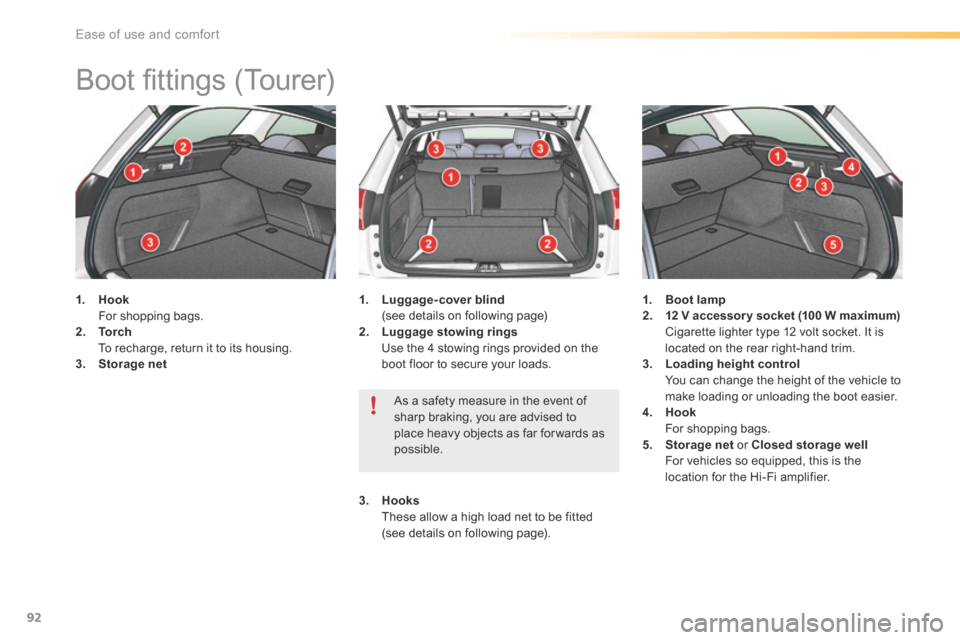
92
C5_en_Chap03_ergo-et-confort_ed01-2015
Boot fittings (Tourer)
1. Hook
For shopping bags.
2. To r c h
To recharge, return it to its housing.
3. Storage net 1.
Luggage-cover blind
(see details on following page)
2. Luggage stowing rings
Use the 4 stowing rings provided on the
boot floor to secure your loads. 1.
Boot lamp
2. 12 V accessor y socket (100 W maximum)
Cigarette lighter type 12 volt socket. It is
located on the rear right-hand trim.
3. Loading height control
You can change the height of the vehicle to
make loading or unloading the boot easier.
4. Hook
For shopping bags.
5. Storage net or Closed storage well
For vehicles so equipped, this is the
location for the Hi-Fi amplifier.
As a safety measure in the event of
sharp braking, you are advised to
place heavy objects as far for wards as
possible.
3. Hooks
These allow a high load net to be fitted
(see details on following page).
Ease of use and comfort